Get Wet and Wild with the Naked Scientists! We don our wellies and wade into the science of wetlands, discovering the species you might see and why wetlands are vital for wildlife on land and at sea. We'll also find out how wetlands protect us from floods, and what can be done to conserve them in the face of climate change. Also in this weeks show, how Humans are fatally infecting Chimps with the common cold, the culture of a chameleon's colours and onions that can't make you cry! Plus, in Kitchen Science we hear the radio signal from a remote control, and find out how you can answer your mobile phone before it even starts ringing!
In this episode
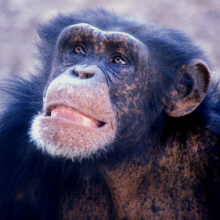
01:24 - Humans "prime-ate" suspects for giving chimps killer diseases
Humans "prime-ate" suspects for giving chimps killer diseases
Recent research carried out in West Africa has shown that humans are fatally infecting chimpanzees with our common cold viruses.
Primatologist Sophie Kondgen, from the Robert Koch Institute in Berlin, examined clinical samples collected from ill chimpanzees during respiratory disease outbreaks at a research site in the Cote D'Ivoire between 1999 and 2006. During the outbreaks, 92% of the animals at the study site developed symptoms and up to 20% of them subsequently died with the majority of fatalities affecting very young animals.
The results of the analysis were surprising because the same two viral offenders were identified in all of the samples collected from the stricken animals. The culprits were two human viral infections called RSV - respiratory syncitial virus, and HMPV - human metapneumovirus, both of which causes coughs and wheezy symptoms in young children and more mild infections in adults. Intriguingly, tests on the viruses showed a series of characteristic genetic changes. The same molecular fingerprint had emerged shortly before in humans in South America, proving that the animals were almost certainly picking up the infections through human contact.
There are several possibilities to account for how the agents are spreading to the chimps including poaching and tourism, but researchers themselves, because they spend long periods of time making observations close to the animals, are also prime suspects.
Kondgen and her colleagues, who are about to publish their findings in Current Biology, think that the viruses themselves are necessarily fatal to the animals but instead make them susceptible to bacterial infections, triggering a fatal pneumonia. But is the solution to ban humans from getting close to the animals?
It's difficult because, as the team point out, human presence on the one hand is good for the chimps' survival because it deters poachers, and the revenue from tourism encourages conservation. Instead, to tackle the problem, the researchers suggest mandatory vaccination programmes for visitors, removal of human waste that could be infectious and the wearing of face masks capable of blocking the spread of viral particles.
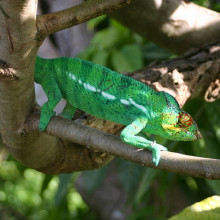
Colourful Chameleons
Something that we all know about the natural world is how the colourful chameleons are masters of disguise changing the way they look to blend perfectly with their surroundings, hiding away from would-be predators that they are too slow to run away from.
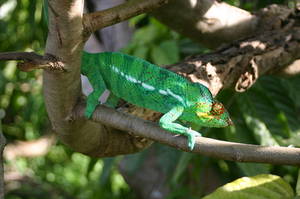 And we might expect that the need to camouflage themselves must have been the reason chameleons first evolved the ability to change colour.
And we might expect that the need to camouflage themselves must have been the reason chameleons first evolved the ability to change colour.
But now a new study from researchers Devi Stuart-Fox and Adnan Moussalli have come up with support for an alternative theory. It could be that chameleons adopted their colourful lifestyles not to blend in but instead to be as conspicuous as possible so they could communicate with each other, in particular for males to display their dominance over other males during disputes over female mates.
To test this idea, the team visited African rainforests where they conducted some bizarre experiments on African Dwarf chameleons - they set up a series of duels between competing males to see which one became the most flamboyantly coloured during battles for supremacy - the winner displays his victory with gaudy bright colours while the looser admits defeat, with dull drab colours. The researchers placed two different males on the same branch and waited until a fight was about to break out. They then measured the colours of the winning and loosing males using a gadget that determines the wavelengths of colour that bounces off an object (called reflectance spectrometry)
The researchers used the same technique to measure the colour of the surrounding vegetation where each species of chameleon is usually found. They then used data from earlier studies about the types of receptors in the eyes of both chameleons and their main predators, birds, to work out how conspicuous each chameleon would appear against the background of their normal habitat.
What they found was that the chameleon species showing the most dramatic colour changes were also putting on the most eye-catching displays for other chameleons, making themselves very obvious against the surrounding vegetation. They also found that of all the chameleons they studied, those that could change colours the most did not live in habitats that were particularly variable - so they probably weren't changing colour because they had to blend into a range of different backgrounds.
The researchers think that chameleons may have first evolved the ability to change colour to help them maintain their body temperature, and that subsequently some chameleons began to communicate to each other using bright, flashy colours.
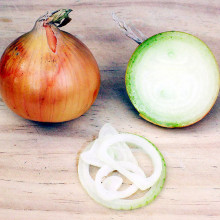
Shed a tear for the humble onion
Scientists in New Zealand have used GM technology to develop onions that can't make you cry.
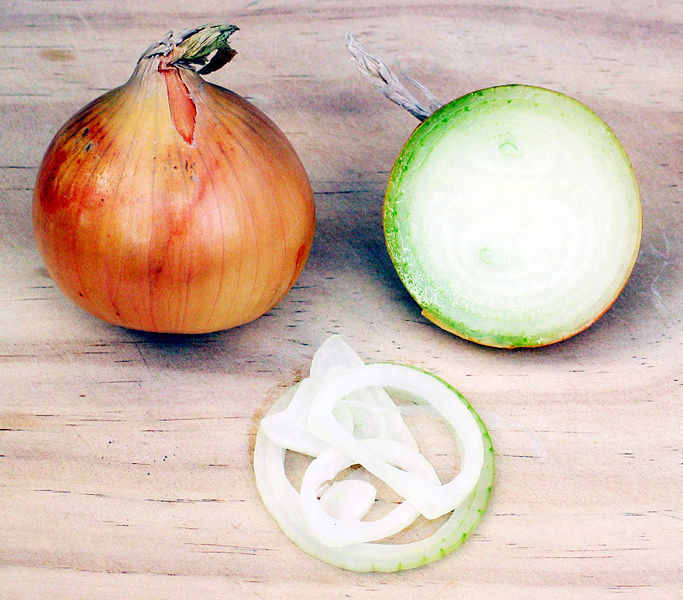 Working with colleagues in Japan, Colin Eady, who is based at New Zealand Crop & Food Research, has successfully silenced the gene responsible for producing the lacrimatory (tear-jerking) factor, which is a volatile chemical called syn-propanethial-S-oxide and is emitted by freshly cut onions. Originally scientists thought that the chemical was pre-made within the vegetable, so preventing its production would probably interfere with the flavour of the onion. But in 2002 scientists in Japan successfully unpicked the chemical pathway responsible for its formation.
Working with colleagues in Japan, Colin Eady, who is based at New Zealand Crop & Food Research, has successfully silenced the gene responsible for producing the lacrimatory (tear-jerking) factor, which is a volatile chemical called syn-propanethial-S-oxide and is emitted by freshly cut onions. Originally scientists thought that the chemical was pre-made within the vegetable, so preventing its production would probably interfere with the flavour of the onion. But in 2002 scientists in Japan successfully unpicked the chemical pathway responsible for its formation.
Cutting into an onion releases the enzyme allinase, which breaks down a family of pungent chemicals in the onion called amino acid sulphoxides. Two further chemical steps, one of them achieved with the help of a second enzyme discovered by the Japanese and known as "lacrimatory factor synthase", yields thesyn-propanethial-S-oxide. It's this final step in the pathway that has been targeted by the researchers who have used a technique called "gene silencing" to deactivate the enzyme. The result is an onion that tastes great but doesn't reduce you to tears.
In fact, according to Eady, preventing the sulphur compounds from being converted into the tearing agent redirects them into compounds responsible for flavour and health, so the process could even improve the taste of the onion. "We anticipate that the health and flavour profiles will actually be enhanced by what we've done," he said.
But cooks hungry to embrace the new eye-friendly foodstuff will have to wait for at least ten years before it is commercially available, says Eady. So in the meantime why not resort to folklore, which says that burning a candle close to where you are chopping an onion can help to burn of the irritant vapours. Or trying chopping your onions underwater - so long as you can hold your breath for long enough!
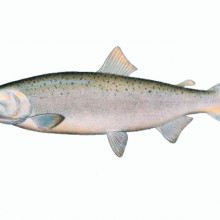
On the profound influence of salmon
Today's programme is about wetlands, so I'm going to get the ball rolling with a piece of science news from Canada. If I was to ask you to think of an aquatic animal that has the ability to change its environment and alter the course of streams and rivers, you would most probably come up with the dam-building beavers.
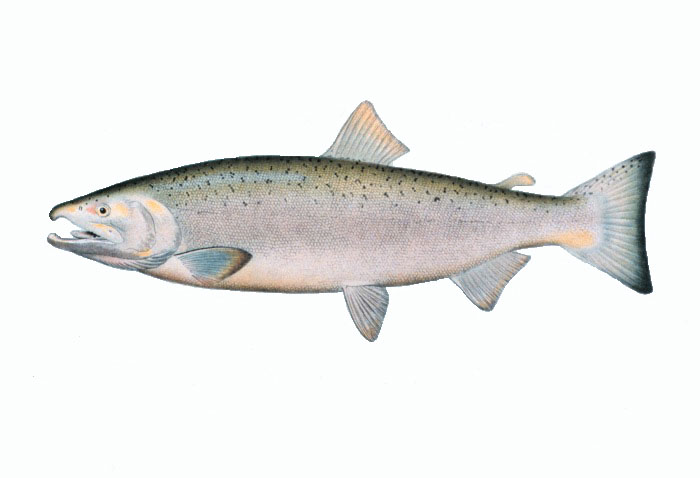 But a new study out this week from researchers based at the University of British Columbia in Vancouver has identified another environment-moulding species - the salmon.
But a new study out this week from researchers based at the University of British Columbia in Vancouver has identified another environment-moulding species - the salmon.
Salmon spend most of their lives at sea, before they undergo an incredible gruelling migration back up rivers to inland freshwater spawning grounds, often leaping up waterfalls to get there. When they arrive, each female lays her eggs in a hollow in the riverbed called a redd that she excavates using her wide tail, like a gardener's hoe. As she does this, she stirs up a lot of sediment that gets swept away in the current.
Until now scientists have long suspected that spawning salmon might have a profound influence of the flow of rivers by stirring up the river bed, but no-one has actually investigated just how much of an effect they can have.
By setting up sediment traps along rivers in British Colombia, researcher Marwan Hassan has discovered for the first time that around half of the sediments that flow down a river in a year come from the upstream activity of spawning salmon. In the headwaters, salmon deepen channels and stir up mud and grit that then flows downstream and ends up in channels and pools lower down - and by stirring up not just sediment but also oxygen, salmon are playing a crucial role in maintaining other wildlife in the river.
This study is really important because it highlights that the shape and dynamics of rivers and streams are based not purely a physical processes but that it has a lot to do with wildlife and biology. And hopefully now by understanding more about the role of spawning salmon, researchers can start to design better ways of restoring health to damaged waterways.

How many watts is a burning candle?
We had an answer on our forum from Bored Chemist. He pointed out that the original standard candle burned a waxy substance called spermaceti. It's called that because it comes from sperm whales.
The best that we have today is, of course, petroleum based wax. The standard candle, he says, would burn 120 grains of spermaceti an hour. That's 8g. Bored Chemist worked out for us that this means that it burns 2.16mg - or about 2 thousandths of a gram - of spermaceti every second.
If we know how much energy is in a gram of this stuff we can work out its wattage, which is essentially energy - in joules - per second of the candle.
Assuming that spermaceti is similar to a typical type of fat or oil, it's about 37 kilojoules (kJ) per gram. The candle was burning 2 thousandths of a gram each second which gives us a power of about 80 watts.
The reason it isn't as bright as an 80W light bulb is because it's really inefficient. Most of that 80W is actually given out as heat rather than light. So it's not like the energy-efficient light bulbs.
Most of the stuff coming off candles is heat. Only about 0.05% of the energy - so not very much at all - comes out as light.
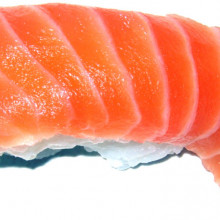
16:31 - Rising Stars - You Feel What You Eat
Rising Stars - You Feel What You Eat
with Caroline Stokes
Can something in your diet be making you feel low? Can the foods you eat possibly help or hinder your mental health? How would you feel if you were told you could improve your mental well-being by small improvements in your diet? The phrase, 'you are what you eat' might soon be adapted to; 'you feel what you eat.'
Research is beginning to show that our diets not only influence our physical health but can affect our mental health too. Most of us experience lows at some stage of our lives whilst some might have an episode of clinical depression. Depression is a major public health problem. Between 5 and 10% of the UK population suffered from depression at any one time. In fact, over a lifetime we all have a 20% chance of suffering an episode of depression. That's one out of every five listeners right now. People with clinical depression often feel low mood or loss of interest and pleasure in usual activities which lasts for at least two weeks.
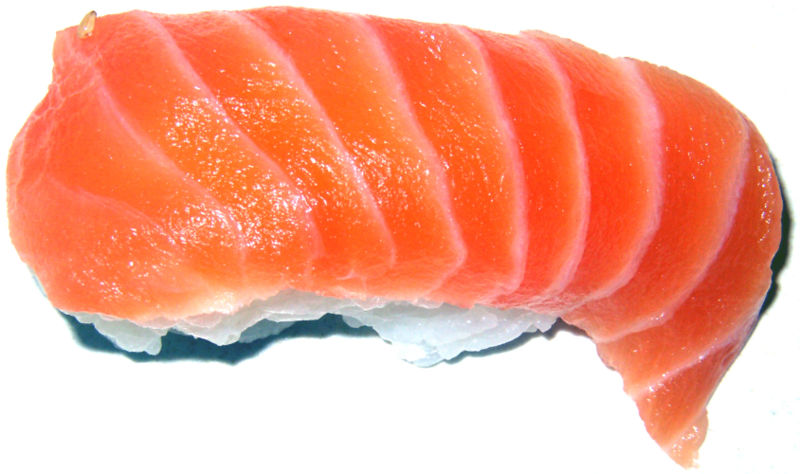 Some studies have shown specific nutrients have beneficial effects on low mood and depression: for example, omega 3 fatty acids and folic acid. An important point to mention is that there is a lot of inconclusive evidence supporting the benefits of omega 3 fatty acids. Many studies are questioned in terms of their study design and scientific validity. The conclusions drawn from these studies should be taken with a pinch of salt, please excuse the pun.
Some studies have shown specific nutrients have beneficial effects on low mood and depression: for example, omega 3 fatty acids and folic acid. An important point to mention is that there is a lot of inconclusive evidence supporting the benefits of omega 3 fatty acids. Many studies are questioned in terms of their study design and scientific validity. The conclusions drawn from these studies should be taken with a pinch of salt, please excuse the pun.
Going back to the scientific evidence for the benefits for omega 3 acids on depression, one study looking at people with clinical depression gave half of them an omega 3 fatty acid capsule and the other half a placebo capsule. The subjects did not know which capsule they were taking and after 12 weeks those receiving the capsule containing the omega 3 fatty acid had marked improvements in their depression compared to those receiving the placebo. You can boost your intake of omega 3 fatty acids by eating oily fish such as salmon, mackerel, herring, sardines and fresh tuna. Folic acid, which is a B vitamin, is found in green leafy vegetables and fortified breads and breakfast cereals.
But don't get hung up on eating one particular food because good dietary habits, including eating breakfast, and plenty of fruits and vegetables and having a home-cooked meal with the family are also suggested to protect against depression.
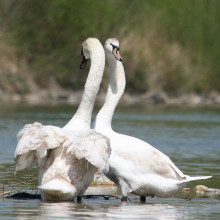
19:39 - Wetlands of London
Wetlands of London
with Martin Senior, Adam Salmon & Michelle Penelle
We are talking about the science of wetlands in this episode of the Naked Scientists and February 2nd was World Wetland day. So to find out more we decided to send our reporter Meera to the London wetlands centre which doesn't seem to be the idea location for wildlife. That's partly because it's in the flight path of Heathrow airport but Meera wondered around the 43ha they've got there which is reed beds, lakes, lagoons and suchlike to find out not only about the species on show but how these ecosystems are protecting us humans as well as the wildlife that live there.
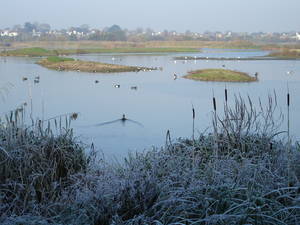 Meera - This week I'm at the London Wetlands Centre on the banks of the river Thames to find out just what goes on in these ecosystems. Wetlands can be found all over the world as bogs, marshes, swamps and fens to name just a few. They house a great diversity of wildlife that can't be found anywhere else. This is because of conditions specific to this ecosystem such as soil that is so waterlogged there's very little room for oxygen. Therefore, the plants you get in these particular wetlands are hydrophytes, meaning water loving, and they've adapted to survive with minimum oxygen.
Meera - This week I'm at the London Wetlands Centre on the banks of the river Thames to find out just what goes on in these ecosystems. Wetlands can be found all over the world as bogs, marshes, swamps and fens to name just a few. They house a great diversity of wildlife that can't be found anywhere else. This is because of conditions specific to this ecosystem such as soil that is so waterlogged there's very little room for oxygen. Therefore, the plants you get in these particular wetlands are hydrophytes, meaning water loving, and they've adapted to survive with minimum oxygen.
That's just one type of wetland condition and the numerous wetland variations are not only important to wildlife populations but to humans as well. I'm here to find out why.
I'm out in the sheltered lagoon on this site with Martin Senior and Adam Salmon who both work for the wildfowl and wetlands trust. Martin, what exactly is a wetland?
Martin - A wetland's habitat where there's water. There's things like streams, ponds, rivers, canals, even your local duck pond. They're all wetlands.
Meera - So Adam, why do you find the plants here and nowhere else?
Adam - They're hugely diverse habitats, wetlands. There's absolutely thousands of species, even here, associated with them. Take a few examples, things like snake's head fritillary is very scarce here in England. That will only do well in the right kind of soil with the right flooding regime. They flourish here because the water levels are right. The management is right: a bit of grazing, a bit of haymaking. Then you've got reed beds that can't be too deep, can't be too shallow when they're planted and when they're pastured as well.
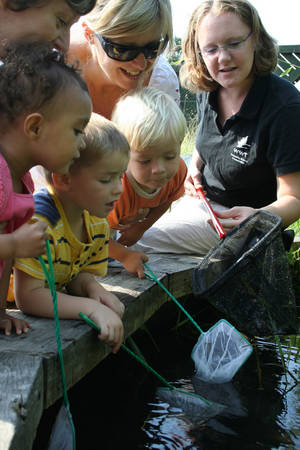 Meera - To get an idea of the types of species you can see in a wetland we're off to the ponds onsite for a bit of dipping. Another member of the team, Michelle Penelle, has joined us. We've all got some nets and we're fishing throughout the water to see what we can get. What have we got in this tray so far, Michelle?
Meera - To get an idea of the types of species you can see in a wetland we're off to the ponds onsite for a bit of dipping. Another member of the team, Michelle Penelle, has joined us. We've all got some nets and we're fishing throughout the water to see what we can get. What have we got in this tray so far, Michelle?
Michelle - Well, we have some beautiful caddisfly larvae.
Meera - You wouldn't be able to tell anything was living in there really. I would think it was random plants in the water.
Michelle - That's the idea because they're hiding from their predators. They've built themselves homes and this species used bits of stick that they've cut off and stuck to their backs with sticky spit. As they grow they add more and more sticks round the collar of their case until it's about April or May. They come to the surface, pupate and then hatch as caddisflies. They wait 'til that time because they feed on pollen from the plants and they need to wait until the flowers are out in the summer season.
We also have some ramshorn snails but we're starting to see things like newts coming out of hibernation. The boys are out first and they're covered in their spots and have crests along their back. They come out to try and attract the females by doing lots of dancing and tail wagging.
Meera - What else could we see that we haven't found to put in our trays today? We've seen the newts and flies and the snails...
Michelle - We've got a few tiny water beetles. There are more in the pond but because it's very cold they're in a sort of dormant state. I'm surprised we still haven't caught any freshwater shrimps because they're very active this time of year and they're all pairing up. The male will actually hold onto a female shrimp and swim around with her in a pair for about a week.
Meera - Something else visitors can do in order to see more of the wildlife is to come into one of the hides. What can we see here, Adam?
Adam - At the moment we've got some shoveler duck out there which are very much winter visitors. At lot of these come from Eastern Europe and as far as Russia even. This winter we've had upwards of three hundred birds. We've also got wintering bittern here at the moment: vary rare species, very scarce in Britain, never mind Greater London.
Meera - What attracts them here then?
Adam - Well, the reed beds habitat specifically as they have to feed out of them. They feel safe wintering in the reed beds at the moment. We've also got widgeon grazing out on the marsh.
Meera - Which ones are the widgeon?
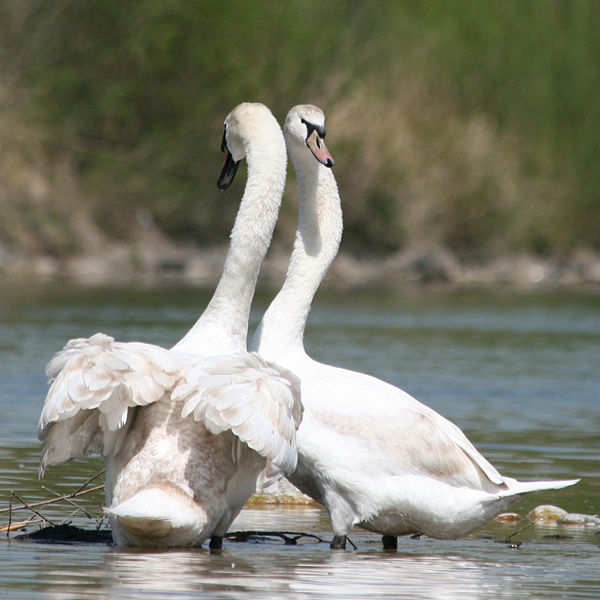 Adam - They're the sort of male birds which have got the quite reddish heads with the yellow stripe over the top. In flight they've got great big white wing bars: one of the more recognisable ducks. At the moment you'll see a lot of pairs of swans out there, mute swans.
Adam - They're the sort of male birds which have got the quite reddish heads with the yellow stripe over the top. In flight they've got great big white wing bars: one of the more recognisable ducks. At the moment you'll see a lot of pairs of swans out there, mute swans.
Meera - Yeah, I can see those.
Adam - Usually there's only one or two of those but this time of year they're all getting their territories sorted out, pairing up. There's a lot of sparring going on so there's a lot of excitement and fights going on all of the time in front of us.
Meera - Are they quite entertaining to see?
Adam - Yeah, yeah. They're quite popular really. They do get very displaced and they'll end up all over the reserve.
Meera - We've done a bit of pond dipping and we've been in the hide so we're back at the sheltered lagoon. Martin, how many wetlands are being lost?
Martin - We know wetlands are disappearing faster than rainforests at the moment. Many of the wetlands are in coastal areas so it's easy when people are looking for extra land to build on. Coastal areas are flat, they drain the marshes and they put huge settlements or often industry. If you look around the British Isles there's often a lot of industry close to the sea where there's obviously ease of transport. There's a huge problem in that every time you lose the wetland you lose the wildlife that's associated with it. You can't just build on wetland, you can't drain wetlands. They're there for a purpose.
Meera - What exactly would the repercussions be if we were to just lose lots of them?
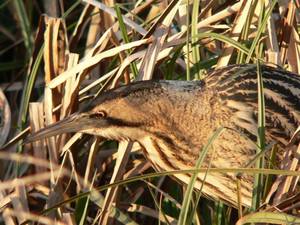 Martin - The repercussions both for this country and round the world are absolutely huge. You've got the things like the loss of wildlife, the loss of biodiversity and with that it'll affect the whole food chain. Also, one of the major effects of losing wetlands is the protective role that they play. Wetlands actually store water and slow it down. When you have these almighty thunderstorms and see flooding this year a lot of the water that comes down I trapped in wetlands. It filters slowly through and they act like a big sponge, slowly releasing it into the rivers and streams. The issue, especially when you build on floodplains, is that all that water falls on tarmac and then straight into the drainage system which runs straight into the rivers. You're inundated with all this water that the system just can't cope with. As we lose more wetlands we lose that effect of controlling and slowing down and moderating what happens when we have heavy rainfall and storms. We've seen how that's affecting people already. We've seen the increase in flooding and the poor people lose all their homes in this country. Now imagine what that's like in these very flat areas like Bangladesh and the impact that's going to have with rising sea levels and loss of wetlands.
Martin - The repercussions both for this country and round the world are absolutely huge. You've got the things like the loss of wildlife, the loss of biodiversity and with that it'll affect the whole food chain. Also, one of the major effects of losing wetlands is the protective role that they play. Wetlands actually store water and slow it down. When you have these almighty thunderstorms and see flooding this year a lot of the water that comes down I trapped in wetlands. It filters slowly through and they act like a big sponge, slowly releasing it into the rivers and streams. The issue, especially when you build on floodplains, is that all that water falls on tarmac and then straight into the drainage system which runs straight into the rivers. You're inundated with all this water that the system just can't cope with. As we lose more wetlands we lose that effect of controlling and slowing down and moderating what happens when we have heavy rainfall and storms. We've seen how that's affecting people already. We've seen the increase in flooding and the poor people lose all their homes in this country. Now imagine what that's like in these very flat areas like Bangladesh and the impact that's going to have with rising sea levels and loss of wetlands.
Meera - So, wetlands are important not only in maintaining unique species of wildlife but protecting human populations from natural disasters such as flooding. So why not visit your local wetland centre and get just a glimpse of the diverse wildlife I've seen here today and also find out more about the ecosystem that protects us from being underwater.
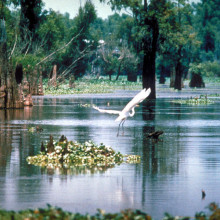
27:22 - Louisiana Wetlands
Louisiana Wetlands
with Dr Robinson Fulweiler, Louisiana State University
Now on the Naked Scientists we're going to go to Louisiana which is where the Louisiana wetlands are. Robinson Fulweiler is a researcher who works there, she's at Louisiana State University.
Chris - Thanks for joining us. First of all, most people probably don't actually know where the Louisiana wetlands are or what they are so could you give us a bit of an introduction to them?
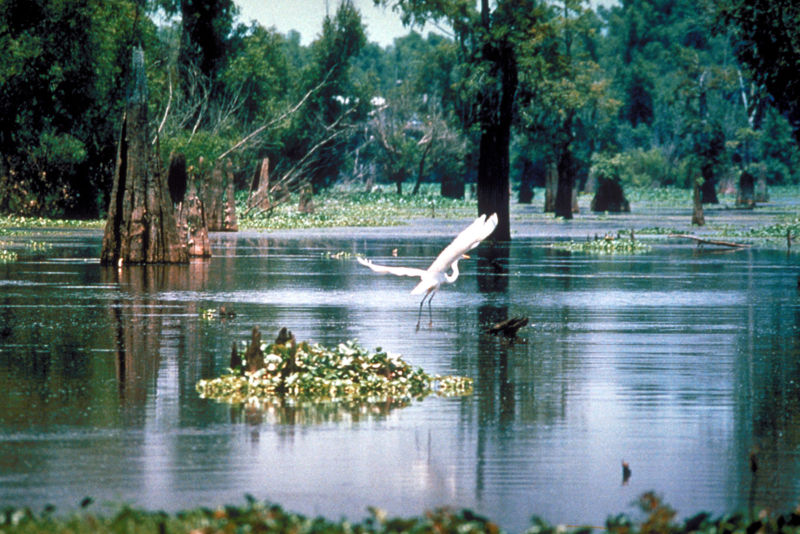 Robinson - Sure. Louisiana is actually about 7500km away from you all right now. I'm at the very southern part of the United States, right next to Texas. The wetlands here are actually the largest wetlands in the United States and they're actually bigger than the island of Cyprus.
Robinson - Sure. Louisiana is actually about 7500km away from you all right now. I'm at the very southern part of the United States, right next to Texas. The wetlands here are actually the largest wetlands in the United States and they're actually bigger than the island of Cyprus.
Chris - They're pretty large. What is special about them?
Robinson - I think the vastness is definitely very important. They make up most of the wetlands in the United States and they're twice the size of the Everglades which is often what people think of as big wetlands.
Chris - What's the actual definition of a wetland? What do we expect to see if we go to one?
Robinson - The main thing, in fact the defining part of a wetland is the fact that there's so much water. And so a lot of the soil is full of water too. Then there's a lot of these plants which I heard you mention too that are called hydrophytes and that's vegetation that's specifically adapted to live in this environment. You can have environments that are freshwater, saltwater or some sort of mix like a brackish wetland.
Chris - How did they get created in the case of the Louisiana? Where did they come from?
Robinson - It's really interesting. The Mississippi river which is one of the largest rivers in the world has been flooding this region for over six thousand years and as it does that it sort of switches its path as it overflows. As the water overflows it brings with it sediments and nutrients and that kinda builds land off to the side of the river. That's how Louisiana was built so it 's been six thousand years in the making basically and it's all from the river system.
Chris - So it's a bit like the same sort of delta system that you would see on, say, the Nile: running past Egypt and Cairo.
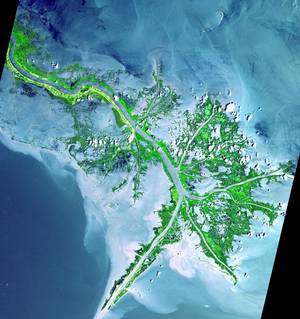 Robinson - Yep, exactly and in fact Louisiana is the seventh largest delta in the world.
Robinson - Yep, exactly and in fact Louisiana is the seventh largest delta in the world.
Chris - Given that people have started to fiddle with the course of the Mississippi because dykes have been built, barrages and it's being diverted does that have a consequence for the growth of these wetlands or their maintenance even?
Robinson - Yes it does. In fact it has a really important negative consequence. That is that since the river is no longer allowed to overflow its banks and bring with it that freshwater sediment and nutrients that the wetlands need the river is instead made into a pipe that now discharges directly into the Gulf of Mexico. Without that rejuvenating resource every year the wetlands are slowly disappearing.
Chris - I should think there's another major consequence which I mentioned at the beginning of the programme which is that the Mississippi is draining right through the heartland of the USA. There's a lot of agriculture going on along its banks and invariably that means nutrients like nitrogen and fertiliser getting into that water. What's the consequence for the ocean then of having what you call a pipe going straight out to sea?
Robinson - One of the main things that we really like about wetlands that provides a really important ecosystem service and that is that it can filter out sediments and nutrients, right. Instead of letting the water flow through wetlands we made this pipe and so all of the nutrients and sediments don't get filtered. It's a direct discharge into the Gulf of Mexico. In fact, I did a little math[s] here and if you think about the amount of nitrogen coming into the Mississippi river and the Gulf of Mexico, it's equivalent to dumping 314,000 elephants each year. There's a lot of nitrogen coming in.
Chris - That's a lot of fertiliser isn't it?
Robinson - It is a lot of fertiliser. That means that we're going to get large phytoplankton blooms, larger than we would normally see because there's extra for them to eat. Large phytoplankton blooms and then these die and sink to the bottom. As they decompose they take up the oxygen in the water. This leads to hypoxia or anoxia, that's either low oxygen or no oxygen in the water: naturally bad for any of the animals that live there.
Helen - Is that already happening on a really large scale? Are we seeing these die-offs taking place?
Robinson - We are, exactly. The dead zone in the Gulf of Mexico, it changes in size from year-to-year, but its biggest has been the size of the State of New Jersey [22,608km2]. It's all usually linked to the amount of water and hence the amount of nitrogen coming from the Mississippi river.
Chris - Does this mean then that if you un-dam and allow the Mississippi river to have its natural course and go back through this natural percolator that you would kill lots of bids with one stone? You'd get your wetlands regenerating themselves, you'd be removing this pollution and you would be benefiting the ocean.
Robinson - Definitely, I think that's the really important thing if you could do that. I think you might need some help from upstream and that is that I think we need to work on best management practices and how much nitrogen fertiliser we put down. Then we can do both, we can lower the actual amount of nitrogen in the Mississippi river then optimise the access into the wetlands.
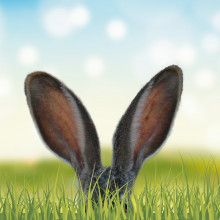
How much ear wax can you produce in a lifetime?
Are you an ear-wax expert? Then we need your help, as we just don't know the answer to this one! Let us know here or see what others think on the forum.
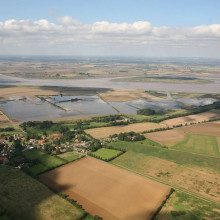
34:06 - Wetlands for Flood Protection
Wetlands for Flood Protection
with John Pygott, Environment Agency
We've heard so far about how wetlands are good for biodiversity and also good places for a day out. Wetlands are also very good for protecting against flooding. Now that might sound like a very silly idea because surely all that water would be a problem when it comes to flood conditions but it seems that wetlands can act like a sponge, soaking up excess water. John Pygott is working for the UK Environment Agency. He's come to talk to us about the Alkborough flood defence system that he's working on where fields have been flooded to create wetlands specifically to act as flood barriers.
Helen - Thanks for coming on the show. I thought we might start by asking you to set the scene for us a little bit to describe where this area is that you're working on and what was the problem? Why did something have to be done in the first place?
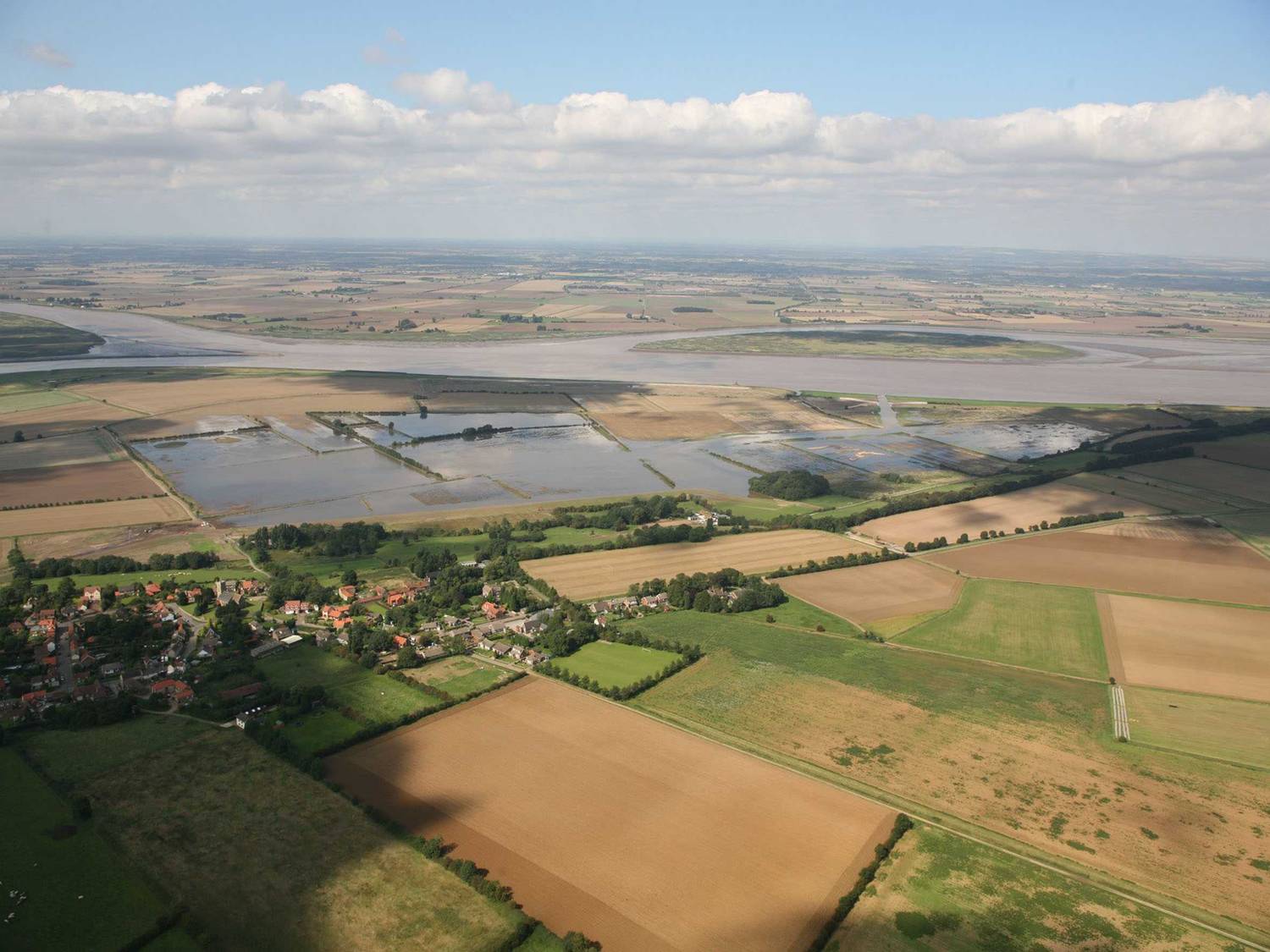 John - The Alkborough project is based on the Humber estuary which is on the North sea coast of England. The problem we've got on the Humber is principally due to sea level rise. Over the past 100 years we've have about 2mm per year or so. We're faced with the situation where we've either got to raise defences higher and higher in the future or alternatively we've got to look at new ways of providing more space for increased amounts of water.
John - The Alkborough project is based on the Humber estuary which is on the North sea coast of England. The problem we've got on the Humber is principally due to sea level rise. Over the past 100 years we've have about 2mm per year or so. We're faced with the situation where we've either got to raise defences higher and higher in the future or alternatively we've got to look at new ways of providing more space for increased amounts of water.
Helen - Where did the idea come from of using land that can be flooded as a way of actually counteracting this rising sea level?
John - The technique of letting water onto land out of rivers has been used quite extensively in the UK. The difference that we've got here is that this is the first time that it's been used on this scale in an estuary. The problem we've been facing is with tidal water rather than high rainfall.
Helen - One question that leaps to mind is that we're living on a very populated island here in the UK. How do you go about securing land to do something like this?
John - That's a very tricky aspect of this type of project. In order to make this work you need very large areas of land: typically in excess of a thousand acres. Those sorts of areas of land are not commonly available in many parts of the UK. We're lucky that there are substantial areas of land like that where there isn't much in terms of houses or property. It is going to be very hard to find in parts of the UK.
Helen - How do you go about making the floodwaters go where you want it to go? Is it a case of there used to be a flood wall that you've taken down or some kind of defence? I'm intrigued to know you can send the water to these areas that you're interested in.
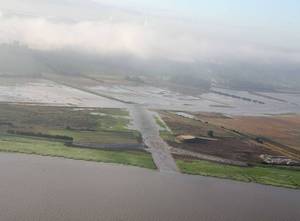 John - It's a little bit more complicated, as you might imagine, than just taking flood banks down. These are areas of land where we've taken short stretches of flood defences away. We're directing the water in at different times with the tide. If you just take the flood defences away it has a whole series of other knock-on effects on things like navigation so it needs a lot more design and planning than just taking sections of defences away.
John - It's a little bit more complicated, as you might imagine, than just taking flood banks down. These are areas of land where we've taken short stretches of flood defences away. We're directing the water in at different times with the tide. If you just take the flood defences away it has a whole series of other knock-on effects on things like navigation so it needs a lot more design and planning than just taking sections of defences away.
Helen - I take it this isn't just a case of providing an area that water can flood into, it's more that there are areas where changes are going to take place within those areas of habitat so what's going to happen when a field is turned into a wetland?
John - What we've seen on the Humber is: the site at Alkborough was flooded a year and a half ago. Already we've seen enormous amounts of sediment coming out of the river onto the old field systems. It's been really dramatic. A lot of the areas of old fields have disappeared now under quite think layers of mud. The mud attracts birds in and the Humber's very important internationally for birds. When you get this sediment you get enormous numbers of wintering wildfowl and waders coming in and feeding on these new areas of mud. It's very dramatic, particularly in winter.
Helen - So having all this wildlife is actually quite an attraction for local people. They must be quite proud of this new habitat that's been created. Is that something that you've discovered?
John - It's been fantastic. What we've seen in some of these areas, in particular Alkborough, is that people have gone from farming which I don't think was particularly profitable to starting to provide facilities for visitors. Already the area Alkborough is attracting a lot of people in for bird watching and walking and so on. A lot of local people have started to realise that there's a business to be made by providing tea rooms and car parking: all kinds of things like that.
Helen - Really it seems like quite a win-win situation. Are there any drawbacks that this kind of project can raise or is it as good as it sounds?
John - There is a drawback in the loss of agricultural land. I think there are concerns now about food security in the UK. We are talking about a permanent loss of farmland. Perhaps in the future that might not be something that's so acceptable as it is now.
Chris - Have there been any negative sentiments from people about your project because you said that the people who are interested in watching the birds find it fantastic. What about the people who've lost land or the people who have to look over the area are they worried about the future of their area? It might be flooded.
John - I think a lot of people are initially quite nervous about the idea of water from estuaries getting nearer to where they live and that's something that we've had to manage quite carefully. We've had to spend a lot of time talking to people, helping them to understand that this is for the wider benefit of the community around the estuary and they continue to be protected from the water. I think that people are nervous about seeing floodwater nearer to their houses.
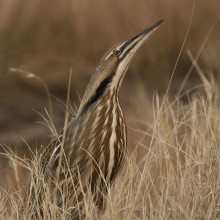
39:50 - Conserving Wetlands
Conserving Wetlands
with Chris Durdin, RSPB
Chris - Now, even though people like
John Pygott are trying to create new wetlands as we've already heard, actually, wetlands are disappearing faster than rainforests. Chris Durdin works for the RSPB, they're trying to find ways to conserve wetlands even in the face of the changing climate so he's on the line with us now. Hello Chris.
Chris D - Hello there.
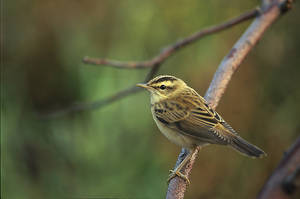 Chris - Thank you for joining us. What are the numbers on losses of wetlands in the UK?
Chris - Thank you for joining us. What are the numbers on losses of wetlands in the UK?
Chris D - I was very struck by the parallels between the USA, the Humber and what's going on in the East of England. Taking the USA first, we're talking large areas of wetlands there in effect, a large delta. You could describe the wash and the fens as a huge delta. The losses there in the fens have been colossal over the years. 97% of all the wetlands have disappeared over last four hundred years.
Chris - It's down to us though isn't it?
Chris D - It's down to us. I think we're talking different time scales here. The big losses in the UK have happened already and I wouldn't like to downplay the existing effects from rising sea levels, water quality, water supplies, abstraction all those kinds of things - even built development. Broadly I think conservation here has moved in recent years onto the front foot. So we're looking now at putting back wetlands from areas where they've been lost. It's a very slow; it's a very expensive process. There's all kinds of bureaucratic hurdles as you might imagine but the process is beginning to happen.
Chris - When you put back a wetland or you create a new one along the lines of what John was talking about with Alkborough is that the same as wetland that's been there for four hundred years?
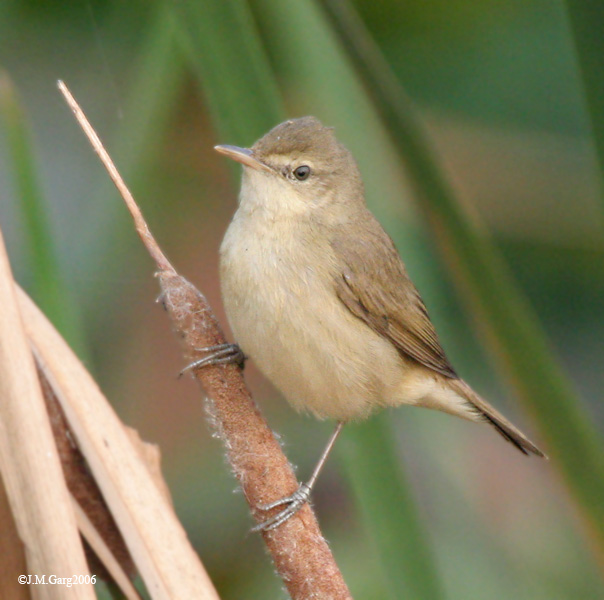 Chris D - It won't be the same but it can be pretty similar. What's happening on the Humber has happened elsewhere in the Eastern counties. There's a scheme on a similar scale at Freestone shore on the Lincolnshire wash and that was a partnership project between the environment agency and the RSPB which is now managing that nature reserve and local authorities. [There are] several schemes in Essex, which is very intricate coast with low-lying areas and many miles of vulnerable sea walls. There's a particularly large project coming up in a place called Wallasea Island which is near Rochford, quite close to the Thames. Here on bits of the Crouch and Roach estuary there's an enormous arable island which bit-by-bit will become a wetland over the coming decades. Again the environment agency has a hand in that, so does the RSPB. These are complex, often multi-agency projects.
Chris D - It won't be the same but it can be pretty similar. What's happening on the Humber has happened elsewhere in the Eastern counties. There's a scheme on a similar scale at Freestone shore on the Lincolnshire wash and that was a partnership project between the environment agency and the RSPB which is now managing that nature reserve and local authorities. [There are] several schemes in Essex, which is very intricate coast with low-lying areas and many miles of vulnerable sea walls. There's a particularly large project coming up in a place called Wallasea Island which is near Rochford, quite close to the Thames. Here on bits of the Crouch and Roach estuary there's an enormous arable island which bit-by-bit will become a wetland over the coming decades. Again the environment agency has a hand in that, so does the RSPB. These are complex, often multi-agency projects.
Chris - So it looks like the future is one for people who need to be interested in birds. There's going to be more wetlands than we know what to do with. Why are they disappearing so fast?
Chris D - In the UK I think they're not going so fast. I'm pleased to say I think we're moving forwards into a new era now. There's various organisations in the fens which are creating new fenlands so the RSPB is doing it in several locations. We have a wetland at Lakenheath Fen which is about 300ha in size and that's been grown on former carrot fields. Now we get booming bitterns, we had cranes breeding there last year. It's a huge reed bed and other wetland complex.
Chris - Since you started to mention birds I was actually going to ask you that. When we have all these wetlands available what sorts of bird success stories have there been?
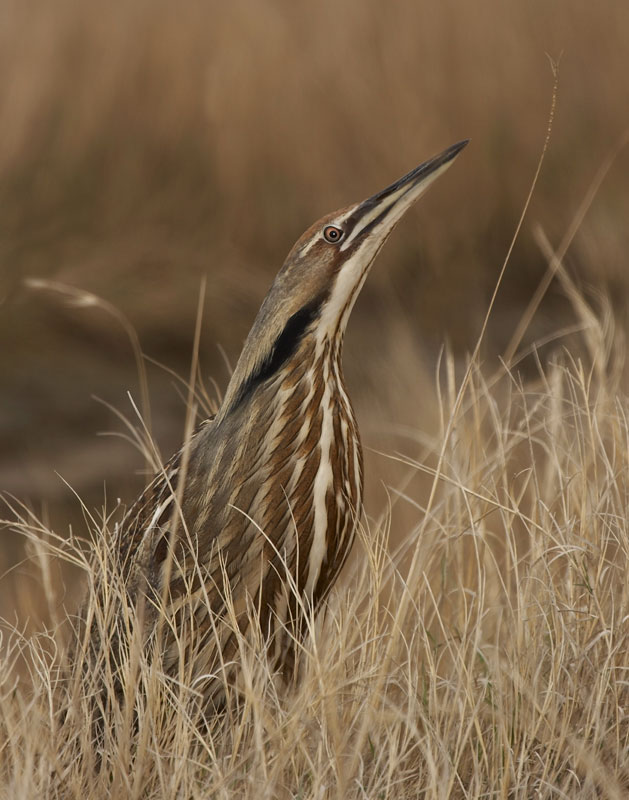 Chris D - Lakenheath Fen is a very good example where we took it over as carrot fields with a few reeded ditches. There was a handful of pairs of reed warblers - six or eight - and now there are several hundred and the same goes for sedge warblers and reed buntings. I suppose it's the iconic wetland species like marsh harriers and bearded tits and bitterns we had to attract. Bearded tits and marsh harriers are back there Bitterns have been there but they haven't bred yet. They have exacting needs in terms of water quality and fish supply. If you can bring them in I think that's a very good indicator that the quality of the wetland is very high indeed.
Chris D - Lakenheath Fen is a very good example where we took it over as carrot fields with a few reeded ditches. There was a handful of pairs of reed warblers - six or eight - and now there are several hundred and the same goes for sedge warblers and reed buntings. I suppose it's the iconic wetland species like marsh harriers and bearded tits and bitterns we had to attract. Bearded tits and marsh harriers are back there Bitterns have been there but they haven't bred yet. They have exacting needs in terms of water quality and fish supply. If you can bring them in I think that's a very good indicator that the quality of the wetland is very high indeed.
Chris - Is it just a question of making the land right, getting the wetland there and then the birds just turn up by default or do you have to do anything else to get them back?
Chris D - Just getting the land right of course is never that simple and there's a whole range of things you have to put in place to do that. For a start you have to make sure that the surrounding areas are not threatened by your new wetland. You could imagine there's a whole range of hoops that you have to leap through. Just add water and get your wetland, well, not quite as simple as that. Certainly at Lakenheath Fen it meant planting several hundred thousand reeds. Most of the wildlife will turn up. One of the most extraordinary things there is that in a former piece of fenland which had been carrot fields for centuries, at various ranges of cultivation, there's an extraordinary seed bank there still remaining and many of the wetland plants have appeared. They're the building blocks and in come the invertebrates. We have introduced some fish there but the birds have all found their own way there themselves.
Chris - I suppose that's one benefit that birds can actually get to places because they have wings!
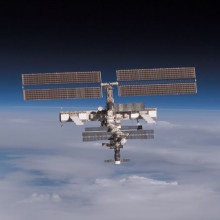
45:08 - Recycling Oxygen?
Recycling Oxygen?
We put this question to Mark Hempsell, Senior Lecturer, University of Bristol...
The oxygen isn't strictly recycled.
The carbon dioxide that the humans breathe out is filtered out of the air with a molecular sieve and then simply dumped overboard.
The oxygen is created from the water that comes from the air and from the washbasins and from the loos.
After that water is cleaned up it is electrolysed. An electric current is passed through it and it is separated into hydrogen and oxygen.
The hydrogen is dumped overboard; the oxygen is fed into the cabin for the crew to breathe.
Do fish always swim anticlockwise in a round bowl?
We were first asked this question in the Naked Scientists Combating Climate Change Show.
Chris: Izzy wrote to me to tell me why she thinks it is. She says, 'There's a simple reason why fish swim in circles and not always in the same direction. There's a current in the bowl. The caller said their fish swam anticlockwise that means that the current in the tank is going clockwise. The fish swim into the current because they get ore oxygen forced into their mouths and through their gills. If the current was going anticlockwise the fish would swim clockwise. If they swam with the current so using less energy to travel they would actually end up worse off because they wouldn't get enough oxygen to make up for the energy they're using to swim at all. It's much more efficient for them to swim into the current. This phenomenon is known as rheotaxis. Helen: I certainly see fish in the wild swimming into currents. I always though it was so they could stay in the same place because you quite often see flickering away into the current. Why is the current there in the tank in the first place? Chris: I wrote to her and said that. And surely the fish swimming would make the water move in the same direction as them and she said, 'My understanding is that when fish swim they push the water behind them in little eddies because nothing's perfectly efficient in the natural world. The eddies cause a spin and this makes the water travel backwards and also turn in the opposite direction to the fish's motion. That's why you then set up a current in the opposite direction to the fish. Helen: Sounds a bit like fish and egg to me. What came first?Chris: I think people have to put it into perspective. Often people have bubblers in the tanks and a bubbler means the bubbles rise asymmetrically up the tank and this pushes the water round in circles. I think she's hit the nail on the head that the fish are going into the current if there is one.
Should you repair a broken dish for food?
Helen: I think if we think about it carefully, it's got to be true that bacteria can get into those cracks and you can't reach them there to scrape them off. There's no physical way of cleaning them out. Bit of water and food can also get into that crack so they can do very nicely, thank you very much, they're safe, they have water to keep themselves going and food. Yes, whether or not it's going to actually have a big effect I don't know. I still drink cups of tea with cracks in and I haven't yet caught anything nasty. Maybe if you're worried about it then yes, don't go there.Chris: I think she's right because you're going to have a bacterial banquet down there. You've got food and water and you can't physically remove the bugs. They could actually be growing in there and then contaminate food. If you, for instance put food on the plate and then store it for a period of time it could contaminate the food. Especially if you put warm food on bacteria grow very, very fast.
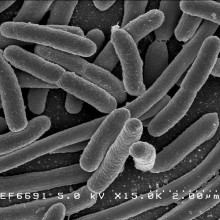
Where does the bacteria in our gut come from?
It will probably surprise you to learn that we're actually passengers in our own body.
If you count the number of bacteria that live on us an in us there are roughly 50 times as many of them as there are cells in our entire bodies. There are roughly a trillion cells in humans, so that's a lot of bacteria.
Where do they come from? Well, the answer is when a baby first pops out, assuming it comes the normal way, its first taste of life is quite literally a mouthful of muck: its mums muck. It's bacteria and other debris that are all over the pelvic floor and perineum of the mother.
When the baby comes out those bugs that are there on the mum go into the baby and they get washed down into the stomach and then into the intestine where they take root. The reason babies can do that and in us most bacteria get killed is because babies don't have much stomach acid at that stage so the bacteria can very easily get in and settle down into the gut.
After a few years they develop and turn into a very unique spectrum which is almost as unique to you as your fingerprint is. If you come out via a different route, say you have a caesarean then the kinds of bacteria that a baby picks up will be different and that's been demonstrated.
Because of the spectrum of bacteria being a bit different there can be consequences for your risk of future diseases including things like getting allergies and also having bouts of diarrhoea.
Recent studies have shown that babies born by caesarean section are actually twice as likely in their first year of life to have doses of diarrhoea and to have allergic reactions to things.
Coming out the right way and getting a mouthful of muck unless you absolutely have to come out the wrong way is probably the best way.
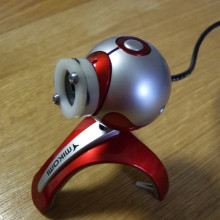










Comments
Add a comment